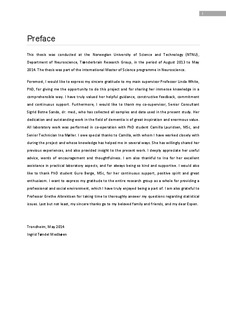| dc.description.abstract | Background:The cerebrospinal fluid (CSF) biomarkers amyloid-beta 42 (Aβ42), total tau (T-tau) and phosphorylated tau (P-tau) are considered to reflect core pathological features of Alzheimer’s disease (AD), and have consistently been reported to have high diagnostic accuracy for discriminating patients with AD from healthy elderly controls. Yet there are limitations to their use, and little is known about alternative proteins in CSF, as well as in blood. The failure of Aβ immunotherapy has forced AD research to examine additional factors, particularly in the early stages of disease. The APOE ε4 allele is the major genetic risk factor for sporadic AD, and data suggest that ApoE may alter Aβ clearance and/or metabolism during the disease process. Another apolipoprotein associated with Aβ metabolism is clusterin (ApoJ), suggested to prevent aggregation and also be involved in clearance of Aβ. Moreover, angiotensin-converting enzyme (ACE) is a protease known to mediate cleavage of Aβ in vitro, and there is some indication that the ACE gene may be a risk factor for AD, depending on the insertion/deletion (I/D) genotype. Neurofilament-light (NF-L), like tau, is a neuronal cytoskeletal protein. In this pilot study, levels of ApoE, clusterin, ACE and NF-L in CSF and/or blood have been investigated in patients with early AD and healthy elderly individuals, and comparisons made with ACE and APOE ε4-allele genotype.
Aims: To assess whether levels of these proteins altered significantly in early AD compared to levels in elderly control individuals healthy for their age, whether additional information could be obtained from comparisons with ACE and APOE polymorphisms, and to assess their potential diagnostic value as early-stage biomarkers for AD compared to Aβ and tau protein.
Methods: Commercial ELISA kits were used to analyze and compare the levels of Aβ42, Aβ40, T-tau, P-tau, ApoE, clusterin, ACE and NF-L in CSF and/or plasma or serum samples from 20 patients with early AD and 20 age-matched individuals healthy for their age. Real-time polymerase chain reaction was performed on genomic DNA purified from samples of whole-blood from all participants to determine the ACE I/D polymorphism. Comparison was also made regarding APOE ε4-allele status.
Results: Despite the low number of samples, a high diagnostic accuracy in the discrimination between patients with early AD and elderly control individuals was obtained with concentrations of Aβ42 and tau in CSF. No significant differences were found between patients with early AD and controls regarding levels of ApoE in serum, clusterin in CSF or plasma, or ACE in CSF or serum. There was no pathological relationship regarding ACE genotype and allele distribution. The APOE ε4-allele was associated with lower levels of serum ApoE, irrespective of diagnosis. CSF NF-L levels were significantly higher in patients compared to controls.
Conclusion: No disease-specific alterations were found in relation to ApoE, clusterin or ACE. Although NF-L in CSF showed a fairly good potential to distinguish the patients with early AD from elderly individuals healthy for their age, the diagnostic accuracy was below that of Aβ and tau protein, and it did not seem to provide improved discrimination as a biomarker. Thus, none of these proteins are likely candidates as biomarkers for early AD. | nb_NO |


